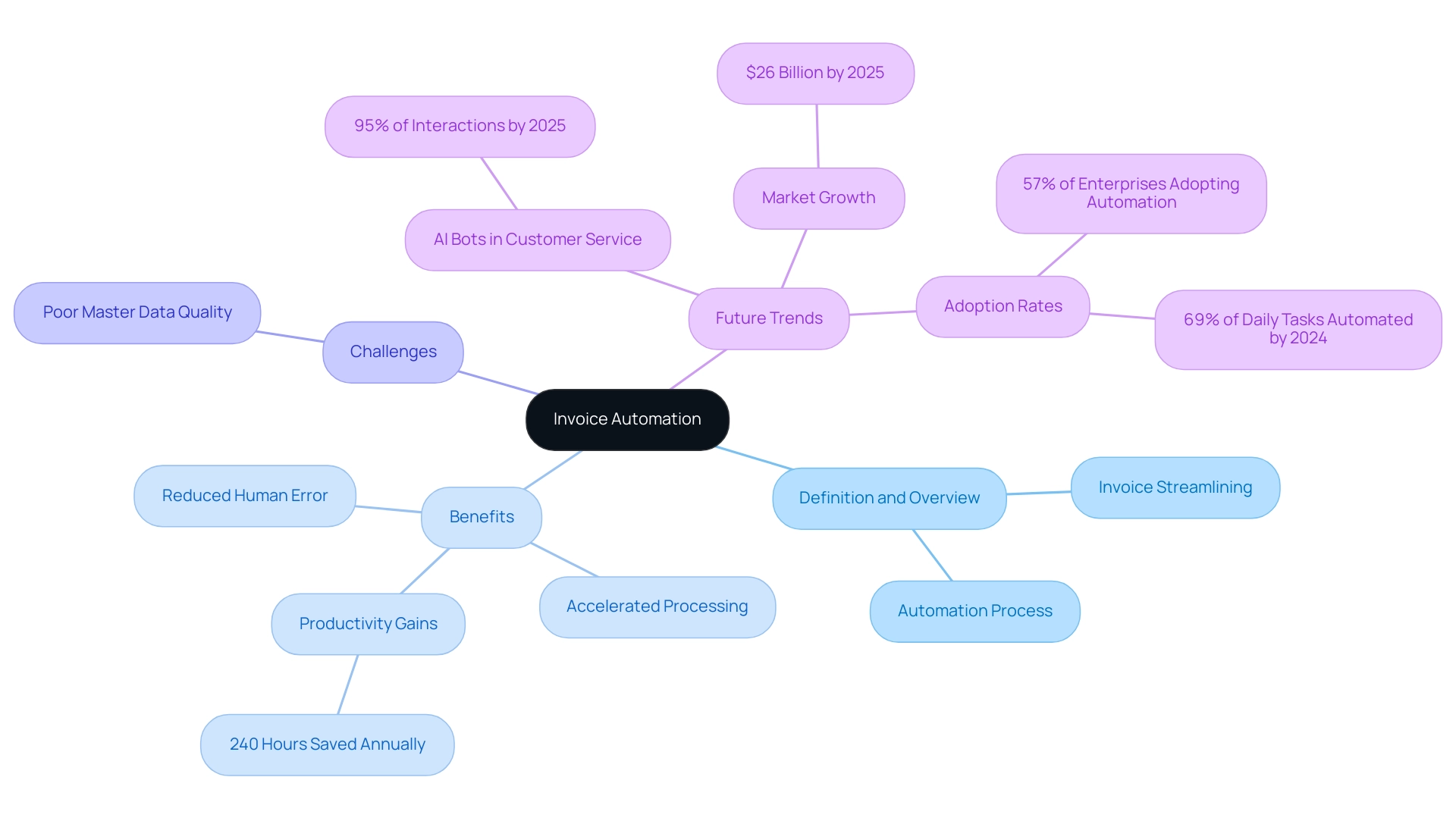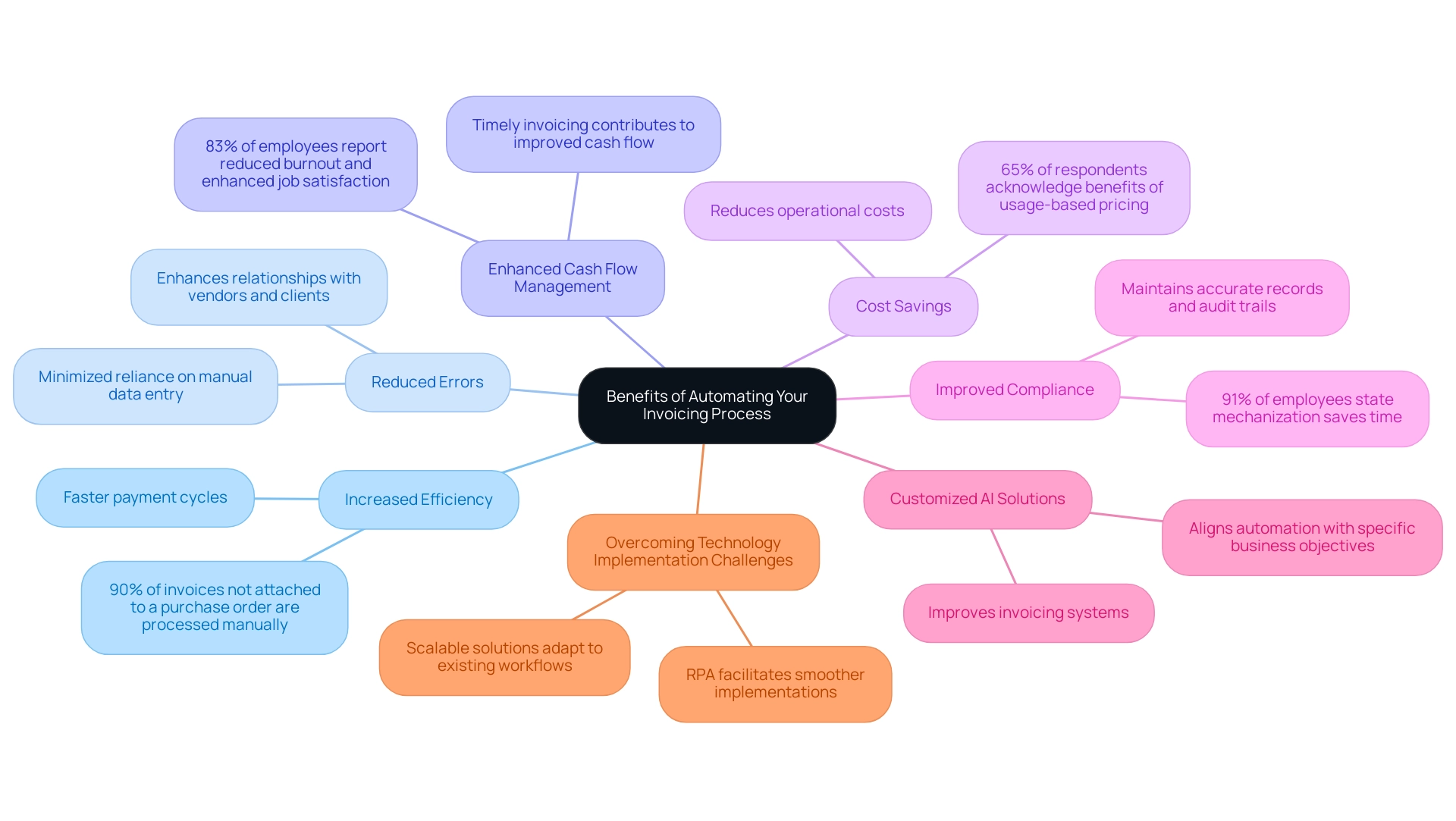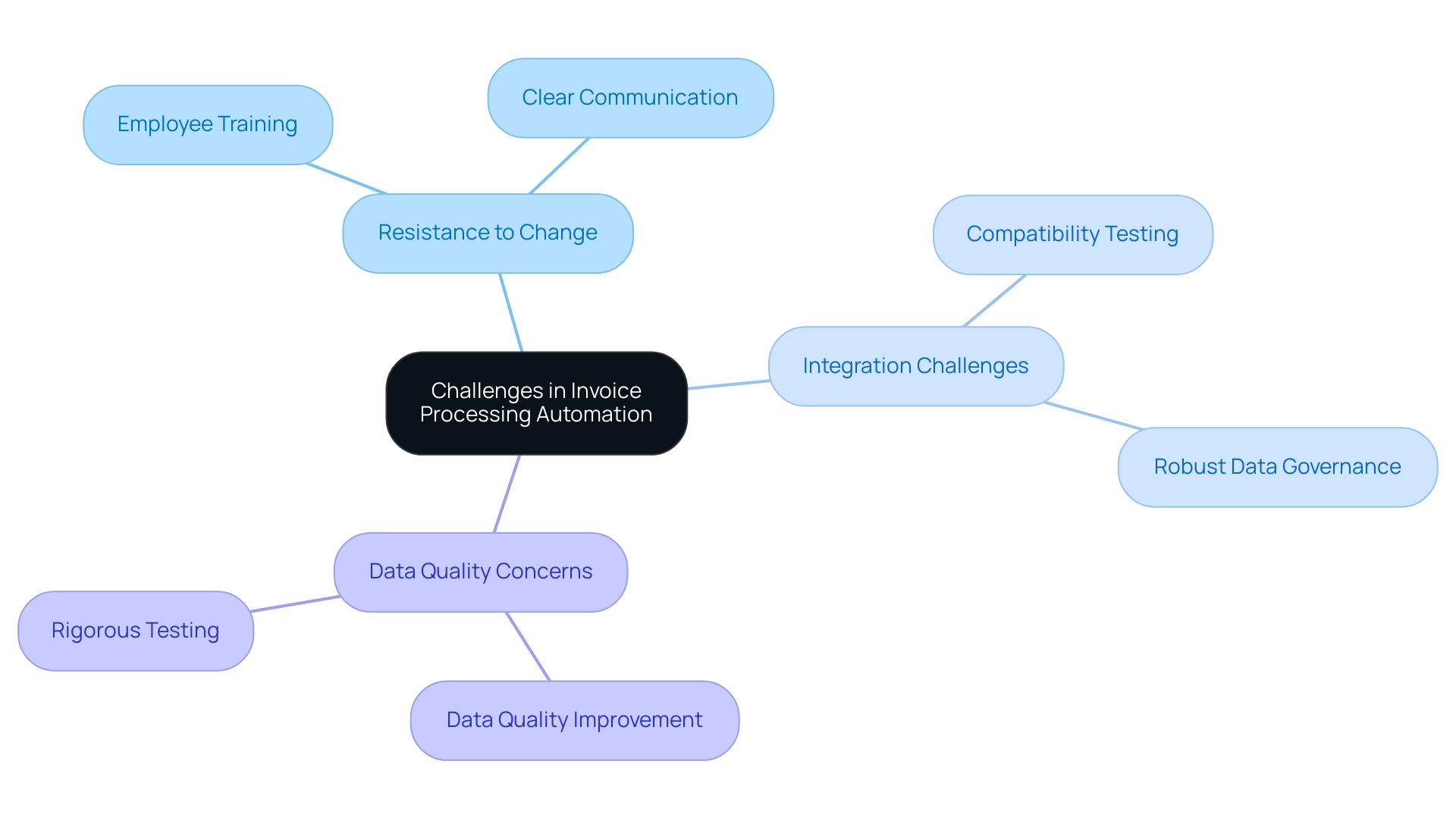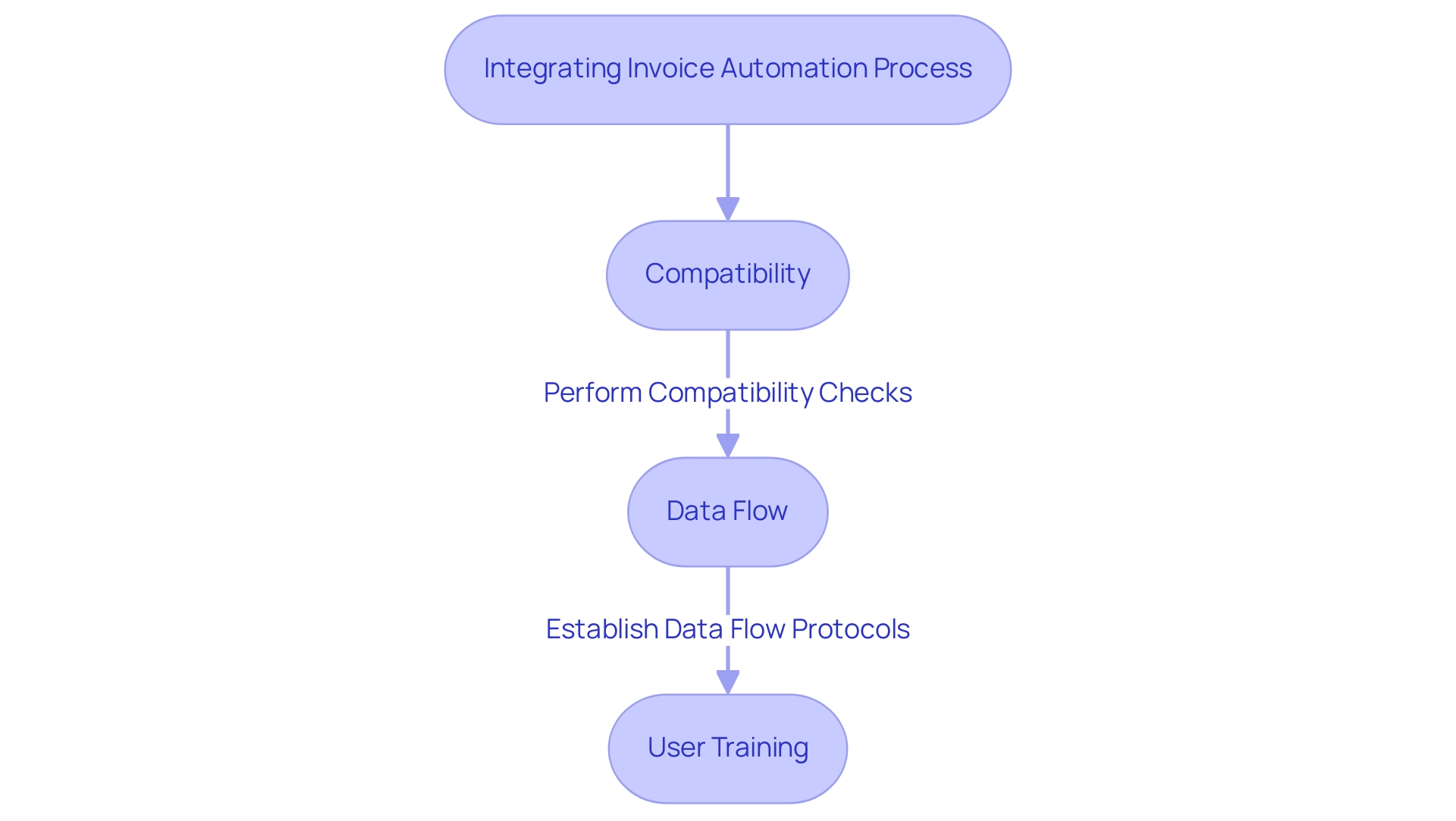Introduction
In the rapidly evolving landscape of business operations, invoice automation emerges as a game-changer, revolutionizing how organizations manage their financial processes. By harnessing advanced technologies, companies can streamline invoicing, reduce manual errors, and enhance compliance, all while freeing up valuable employee time. As organizations grapple with the complexities of adopting automation, understanding the key steps, benefits, and integration strategies becomes essential.
With a focus on overcoming common challenges, businesses can unlock the full potential of automated invoicing, positioning themselves for success in an increasingly competitive marketplace. This article delves into the intricacies of invoice automation, offering practical insights to empower organizations in their journey toward operational efficiency.
Understanding Invoice Automation: Definition and Overview
Invoice streamlining signifies a strategic use of technology aimed at simplifying and mechanizing the entire invoice automation process, significantly minimizing manual intervention. This comprehensive invoice automation process encompasses the generation, approval, and payment of invoices, ensuring not just accuracy but also regulatory compliance. By adopting automated processes, organizations can effectively tackle the common challenges of AI adoption, such as perceived complexity and costs, while reaping benefits like reduced human error and accelerated processing times.
In fact, employees estimate that mechanization could save them approximately 240 hours per year, marking a substantial productivity gain. With over 80% of companies intending to maintain or increase their investment in automated solutions, the invoice automation process represents more than just a technological upgrade; it signifies a critical shift towards more efficient business practices that align with contemporary operational objectives. However, organizations must also address issues related to Poor Master Data Quality, which can hinder the effectiveness of AI initiatives.
For instance, accurate and high-quality data is essential for successful processes, as poor data quality can lead to errors and inefficiencies. As noted by Kateryna Cherniak, an SEO Specialist, digital assistants handle 58% of returns and cancellations, demonstrating the concrete advantages of automated processes. Moreover, the implementation of AI in operational strategies can enhance resilience, as demonstrated by research advocating for multi-agent systems that support SMEs in making informed strategic decisions.
Significantly, forecasts suggest that AI bots will facilitate 95% of all customer service interactions by 2025, while 57% of enterprises intend to embrace automated techniques in the next two years. This trend highlights the urgency for entities to shift towards mechanization, as by 2024, 69% of daily management tasks are anticipated to be mechanized. The market for workflow streamlining procedures is anticipated to grow to $26 billion by 2025, emphasizing the economic significance of investing in solutions to position organizations for success in an evolving marketplace.
Additionally, case studies showcasing successful applications of billing systems can offer tangible examples of the advantages achieved, such as enhanced precision and effectiveness in financial operations.

Key Steps in the Invoice Automation Process
The invoice automation process is a crucial element of the billing process, enhancing operational efficiency by encompassing several essential steps that improve accuracy and streamline workflows. Firstly, Data Capture utilizes Optical Character Recognition (OCR) technology to extract relevant information from incoming invoices, significantly reducing manual entry errors and improving visibility into invoice statuses. With 15% of AP automation tools now featuring AI-powered workflows, as noted by Gartner, the growing relevance of AI is paramount in enhancing data capture capabilities.
EMMA RPA enhances this step by providing advanced data extraction features that integrate seamlessly with existing systems, ensuring higher accuracy and efficiency. Secondly, Validation comes into play, where the system automatically verifies captured data against purchase orders or contracts, ensuring accuracy and compliance. This step is crucial, as 27% of organizations acknowledge enhanced fraud reduction as a direct advantage of automation, emphasizing validation’s role in protecting financial operations.
Power Automate can be utilized here to set up automated alerts for discrepancies, further enhancing security. After validation, the Approval Workflow entails directing bills through established procedures, ensuring that relevant stakeholders examine and sanction payments promptly, which not only speeds up approvals but also improves financial reporting precision. EMMA RPA facilitates this by automating the routing process based on predefined rules, ensuring no billing document is overlooked.
The fourth step, Payment Processing, automates payment execution via integrated financial systems, leading to faster transaction turnaround. Finally, Reporting and Analytics produce valuable insights from billing data, informing strategic financial decision-making. Each of these steps is vital for establishing a seamless billing experience, aligning with current trends in mobile billing that emphasize flexibility and security in managing transactions through mobile applications.
A case study on mobile invoicing trends illustrates how this approach is gaining traction, allowing users to create and manage invoices through mobile apps, driven by the need for improved security and flexibility. By implementing the invoice automation process and other automated systems, companies can significantly boost their operational efficiency, alleviate staffing shortages, and minimize errors, ultimately enhancing employee morale and productivity. However, organizations may face challenges during implementation, such as resistance to change or integration issues with legacy systems.
To overcome these hurdles, it is essential to engage stakeholders early in the initiative, provide adequate training, and ensure that the RPA solutions are compatible with existing workflows. By tackling these challenges in advance, companies can enhance the advantages of RPA in their billing automation systems.

Benefits of Automating Your Invoicing Process
The invoice automation process offers a range of compelling advantages that can transform operational efficiency.
-
Increased Efficiency: Automation significantly accelerates billing processing times, enabling faster payment cycles. Recent reports indicate that 90% of invoices not attached to a purchase order are processed manually, creating a substantial opportunity for RPA to streamline these tasks.
-
Reduced Errors: By minimizing reliance on manual data entry, organizations can drastically lower the chances of errors that often lead to payment disputes. This reduction not only saves time but also enhances relationships with vendors and clients.
-
Enhanced Cash Flow Management: Timely invoicing and efficient payment processing directly contribute to improved cash flow, empowering businesses to manage their finances more effectively. In fact, 83% of employees using AI-powered technology report that it helps reduce burnout and enhances job satisfaction, illustrating the broader impact of such systems on workplace morale.
-
Cost Savings: The time saved on manual tasks translates into significant cost reductions. The 2022 RPA survey conducted by Robocorp revealed that 65% of respondents acknowledged the potential benefits of usage-based pricing, highlighting a trend towards cost-effective solutions. This shift not only reduces operational costs but also aligns with the increasing demand for efficient financial management in healthcare and financial sectors.
-
Improved Compliance: Automated systems facilitate adherence to regulatory requirements by maintaining accurate records and comprehensive audit trails, ensuring businesses remain compliant in a rapidly evolving landscape. Moreover, the case study titled “Employee Productivity and RPA” indicates that 91% of employees state that mechanization saves time and enhances their work-life balance, with 89% feeling more content with their jobs because of mechanization.
-
Utilizing Customized AI Solutions: By incorporating customized AI solutions with RPA, entities can further improve their invoicing systems, ensuring that the automation is not only effective but also aligned with specific business objectives.
-
Overcoming Technology Implementation Challenges: The transition to automated invoicing can often present challenges; however, RPA facilitates smoother implementations by providing scalable solutions that adapt to existing workflows. This adaptability is crucial for maintaining operational continuity during the transition phase.
The integration of RPA and AI not only enhances operational efficiency but also fosters a more productive and satisfied workforce, making the invoice automation process particularly beneficial for healthcare and financial operations.

Overcoming Challenges in Invoice Processing with Automation
While the advantages of the invoice automation process are undeniable, businesses frequently encounter several obstacles during the transition. Key challenges include:
-
Resistance to Change: A significant portion of employees may show reluctance to embrace new technologies, often stemming from a lack of understanding or fear of the unknown. In fact, statistics indicate that approximately 60% of employees resist technological changes due to uncertainty about their roles.
-
Integration Challenges: Numerous entities struggle with compatibility issues between current systems and new technological tools, which can obstruct the seamless execution of processes.
-
Data Quality Concerns: Inadequate data quality can severely impact the efficiency and effectiveness of automated processes, leading to errors and inefficiencies.
To mitigate these challenges, organizations should prioritize employee engagement through comprehensive training programs that foster a culture of adaptability.
Patience and assistance for team members and suppliers are vital in attaining higher utilization rates during the shift to mechanization. Furthermore, ensuring rigorous testing of integrations and establishing robust data governance practices will significantly enhance data quality prior to deployment. Our risk-free ROI-driven method ensures that entities only pay for successful implementations.
We start by evaluating a procedure appropriate for mechanization, calculating the effort needed, estimating time savings, and ultimately implementing the system with certified professionals. Significantly, a case study named ‘Time Savings from the invoice automation process’ indicates that the invoice automation process can save organizations over 70% of the time dedicated to accounts payable activities, enabling finance teams to handle up to 30 bills each hour, greatly enhancing productivity. As Mary Schaeffer wisely advises,
Don’t tolerate someone like me that only reads a quarter of the manual that applies to them,
indicating the importance of clear communication and user-friendly transition processes to minimize resistance and maximize compliance.
Furthermore, leveraging Business Intelligence can transform raw data into actionable insights, enabling informed decision-making that drives growth and innovation. Automation can result in significant savings, potentially totaling hundreds, thousands, or even millions, depending on volume and size.

Integrating Invoice Automation with Existing Business Systems
The integration of invoice processing with existing business systems is crucial for unlocking its full potential and driving operational success. Key considerations include:
-
Compatibility: It’s essential to verify that the tools can seamlessly connect with current accounting and ERP systems. Recent statistics reveal that 32% of entities cited security breaches and 25% mentioned integration concerns as primary reasons for avoiding ERP cloud solutions, while 19% cited the risk of data loss.
This emphasizes the need for robust compatibility checks to mitigate these risks. -
Data Flow: Establishing clear data flow protocols is vital for maintaining consistency and accuracy across platforms. Effective data management in the context of the invoice automation process is supported by techniques from time series analysis, such as ARIMA and exponential smoothing, which can help entities forecast and manage data trends efficiently.
-
User Training: Comprehensive training for staff is imperative to familiarize them with the new integrated system. This not only facilitates smoother transitions but also alleviates integration concerns, which 25% of entities reported as a significant barrier. Furthermore, entities often encounter staffing shortages and outdated systems that impede operational efficiency.
By prioritizing these areas and leveraging RPA, organizations can combat repetitive tasks, enhance productivity, and ensure efficient operations while minimizing risks associated with automation and data management. Furthermore, incorporating Business Intelligence can transform raw data into actionable insights, enabling informed decision-making that drives growth and innovation.

Conclusion
Embracing invoice automation is a transformative step that organizations can take to enhance their operational efficiency and financial processes. By understanding the definition and overview of invoice automation, businesses can appreciate how it streamlines invoicing through advanced technologies, reducing manual errors and ensuring compliance. The key steps in the process, including data capture, validation, approval workflows, payment processing, and reporting, illustrate how automation can significantly improve accuracy and speed while also addressing common challenges such as data quality and integration issues.
The benefits of automating invoicing are compelling, ranging from increased efficiency and reduced errors to improved cash flow management and compliance. Organizations that leverage tailored AI solutions alongside RPA not only streamline their invoicing processes but also foster a more engaged and satisfied workforce. However, overcoming challenges such as resistance to change and integration hurdles is essential for a successful transition.
By prioritizing employee training and establishing robust data governance practices, companies can maximize the effectiveness of their automation initiatives.
Ultimately, integrating invoice automation with existing business systems is crucial for unlocking its full potential. As organizations navigate the complexities of automation, they position themselves to thrive in a competitive marketplace. The journey towards operational efficiency through invoice automation is not just a technological upgrade; it is a strategic move that empowers organizations to achieve greater productivity, cost-effectiveness, and resilience in their financial operations.
Now is the time to embrace this change and harness the capabilities of automation for sustained success.

